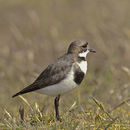en
names in breadcrumbs


Charadrius is a genus of plovers, a group of wading birds. The genus name Charadrius is a Late Latin word for a yellowish bird mentioned in the fourth-century Vulgate. They are found throughout the world.
Many Charadrius species are characterised by breast bands or collars. These can be (in the adult) complete bands (ringed, semipalmated, little ringed, long-billed), double or triple bands (killdeer, three-banded, Forbes', two-banded, double-banded) or partial collars (Kentish, piping, snowy, Malaysian, Javan, red-capped, puna).
They have relatively short bills and feed mainly on insects, worms or other invertebrates, depending on habitat, which are obtained by a run-and-pause technique, rather than the steady probing of some other wader groups. They hunt by sight, rather than by feel as do longer-billed waders like snipe.
Species of the genus Aegialites (or Aegialitis) are now subsumed within Charadrius.
The genus Charadrius was introduced in 1758 by the Swedish naturalist Carl Linnaeus in 1758 in the tenth edition of his Systema Naturae.[1] The name had been used (as Charadrios sive Hiaticula) by the Italian naturalist Ulisse Aldrovandi in 1603 for the common ringed plover.[2] The word is Late Latin and is mentioned in the Vulgate Bible. It derives from the Ancient Greek χαραδριος/kharadrios, an unidentified plain-coloured nocturnal bird that was found in ravines and river valleys (from kharadra, "ravine").[a][4] The type species is the common ringed plover.[5]
The genus contains 32 species.[6]
In December 2020, it was described in a paper that the Kentish plover subspecies C.a.seebohmi may be a new species, the Hanuman plover.
Kentish plover (C. alexandrinus)
Semipalmated plover (C. semipalmatus)
Three-banded plover (C. tricollaris) eggs on open ground
Little ringed plover (C. dubius) chick
Charadrius is a genus of plovers, a group of wading birds. The genus name Charadrius is a Late Latin word for a yellowish bird mentioned in the fourth-century Vulgate. They are found throughout the world.
Many Charadrius species are characterised by breast bands or collars. These can be (in the adult) complete bands (ringed, semipalmated, little ringed, long-billed), double or triple bands (killdeer, three-banded, Forbes', two-banded, double-banded) or partial collars (Kentish, piping, snowy, Malaysian, Javan, red-capped, puna).
They have relatively short bills and feed mainly on insects, worms or other invertebrates, depending on habitat, which are obtained by a run-and-pause technique, rather than the steady probing of some other wader groups. They hunt by sight, rather than by feel as do longer-billed waders like snipe.
Species of the genus Aegialites (or Aegialitis) are now subsumed within Charadrius.